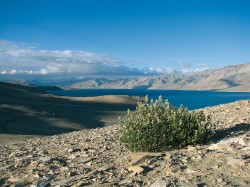Celkové počty bakterií v půdách pohoří Ladak (Indie) nejsou ovlivněny polštářovitou rostlinou Thylacospermum caespitosum (čeledˇ hvozdíkovité, patří k tzv. ekosystémovým inženýrům) ani nadmořskou výškou (4 600 – 5 900 m n.m.), ale tyto dva faktory ovlivňují složení mikrobiálního společenstva. Získaná data rozšířila znalosti o r/K strategii heterotrofních bakterií půd v alpínském a subniválním pásu Himálaje, kde doposud nebyla provedena na toto téma žádná studie.
The total number of bacteria in soils of the Ladakh Mountains (India) are not affected by the cushion plant Thylacospermum caespitosum (family Caryophyllaceae, the ecosystem engineer) and the altitude (4,600–5,900 m a. s. l.), but these two factors affect the composition of microbial communities. The data obtained in this pioneer study extend our knowledge of the r/K-strategy of heterotrophic bacterial species in soils of the Himalayas.
 Jezero Tsomoriri. Ladak. Foto M. Dvorský
Jezero Tsomoriri. Ladak. Foto M. Dvorský








